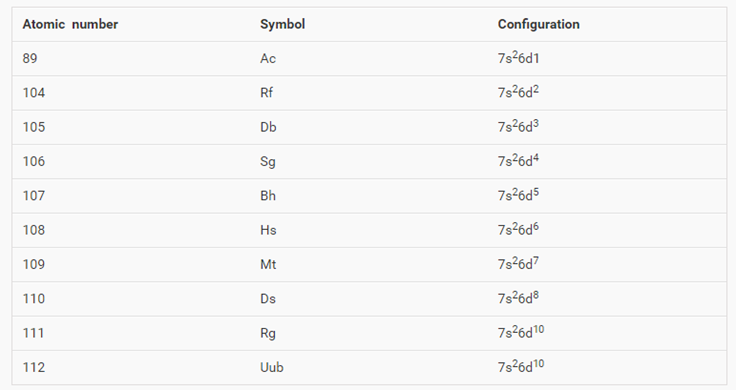Electronic Configuration of Elements
Table of Content |
Introduction to Electronic Configurations of d-Block Elements
The elements which lie in the middle of the Group IIA elements and the Group II B elements in the present day periodic table are known as the d block elements. The d-block elements may also be known as Transition Elements.
Fig. a: d-block elements
Electronic Configuration
Electronic configuration of an element is characterized as an arrangement of electrons in the orbital. Orbital s, p, d, and f are the four chief nuclear orbitals which ought to be filled by the number of electrons and the energy level of the orbital. The four orbitals can be organized by their energy level as s< p< d< f. As indicated by Aufbau's principle the most reduced energy orbital ought to be filled first. The s orbital can get two electrons while p, d and f orbitals can hold 6, 10 and 14 electrons separately.
Generally, the electronic configuration of these elements is (n-1) d 1–10ns 1–2. The (n–1) remains for the inward d orbitals which may have one to ten electrons and the peripheral ns orbital may have one or two electrons. The d–block involves the middle area flanked by s– and p– blocks in the periodic table. The very name "transition" given to the elements of d-block is simply because of their position amongst s– and p– block elements. The d–orbitals of the penultimate energy level in their atoms get electrons leading to the three columns of the transition metals, i.e., 3d, 4d and 5d. The fourth line of 6d is still inadequate. These series of the transition elements are displayed in figures beneath.
Be that as it may, this speculation has a few special cases as a result of extremely low energy contrast between (n-1) d and ns orbitals. Moreover, half and totally filled arrangements of orbitals are moderately more stable. An outcome of this figure is mirrored the electronic configurations of Cr and Cu in the 3d series. Consider the instance of Cr, for instance, which has 3d54s1 rather than 3d44s2; the energy gap between the two sets (3d and 4s) of orbitals is sufficiently little to anticipate electron entering the 3d orbitals. Also in the event of Cu, the configuration is 3d104s1 and not 3d94s2. The electronic configuration of first row transition element is appeared in the table beneath.
1st Series of Electronic Configuration
So, we sum up the external configuration of first line transition elements as 4s23dn. In any case, from the above table, we can see that chromium and copper don't follow this example. This is a result of very low energy distinction between the 3d shell and 4s shell. It is tentatively found that half and totally filled arrangements of orbitals are more stable. On account of chromium and copper, the energy contrast between the orbitals is less so it can't keep the electrons entering in the d shell. The electronic configuration of d-block element in the advanced periodic table can be composed as displayed in the table beneath:
2nd Series of Electronic Configuration
3rd Series of Electronic Configuration
4th Series of Electronic Configuration
Zn, Cd and Hg have their orbitals completely filled both in their ground state and in their common oxidation states and is represented as (n-1) d10 ns2. So, they are not referred to as transition elements.
Frequently Asked Questions (FAQs)
Q1. What elements are in the d- block?
Sol. Diagram showing the elements of the three d- block series is as follows:
Q2: Which elements are known as d- block elements?
Sol. The d-block elements exist in groups 3, 4, 5, 6, 7, 8, 9, 10, 11, and 12 of the periodic table; d-block elements are also known as the transition metals. The d orbital is filled with the electronic shell “n-1.” The partially filled subshells incorporate the (n-1) d subshell. All the d-block elements have a similar number of electrons in the furthest shell. Consequently, they indicate comparable chemical properties.
- Zn, Cd and Hg have their orbitals completely filled both in their ground state and in their common oxidation states and is represented as (n-1) d10 ns2. So, they are not referred to as transition elements.
Q3. Why d- block elements are colored?
Sol. Compounds of transition elements that are colored are related with somewhat incompletely filled (n-1) d orbitals. The transition metal particles containing unpaired d-electrons experience electronic transition starting with one d-orbital then onto the next. Amid this d-d transition phenomenon, the electrons ingest certain energy from the radiation and transmit the rest of energy as colored light. The shade of particle is reciprocal of the shading consumed by it. Consequently, colored particle is framed because of d-d transition which falls in visible area for all transition components.
Watch this Video for more reference
More Readings
View courses by askIITians


Design classes One-on-One in your own way with Top IITians/Medical Professionals
Click Here Know More

Complete Self Study Package designed by Industry Leading Experts
Click Here Know More

Live 1-1 coding classes to unleash the Creator in your Child
Click Here Know More

a Complete All-in-One Study package Fully Loaded inside a Tablet!
Click Here Know MoreAsk a Doubt
Get your questions answered by the expert for free





